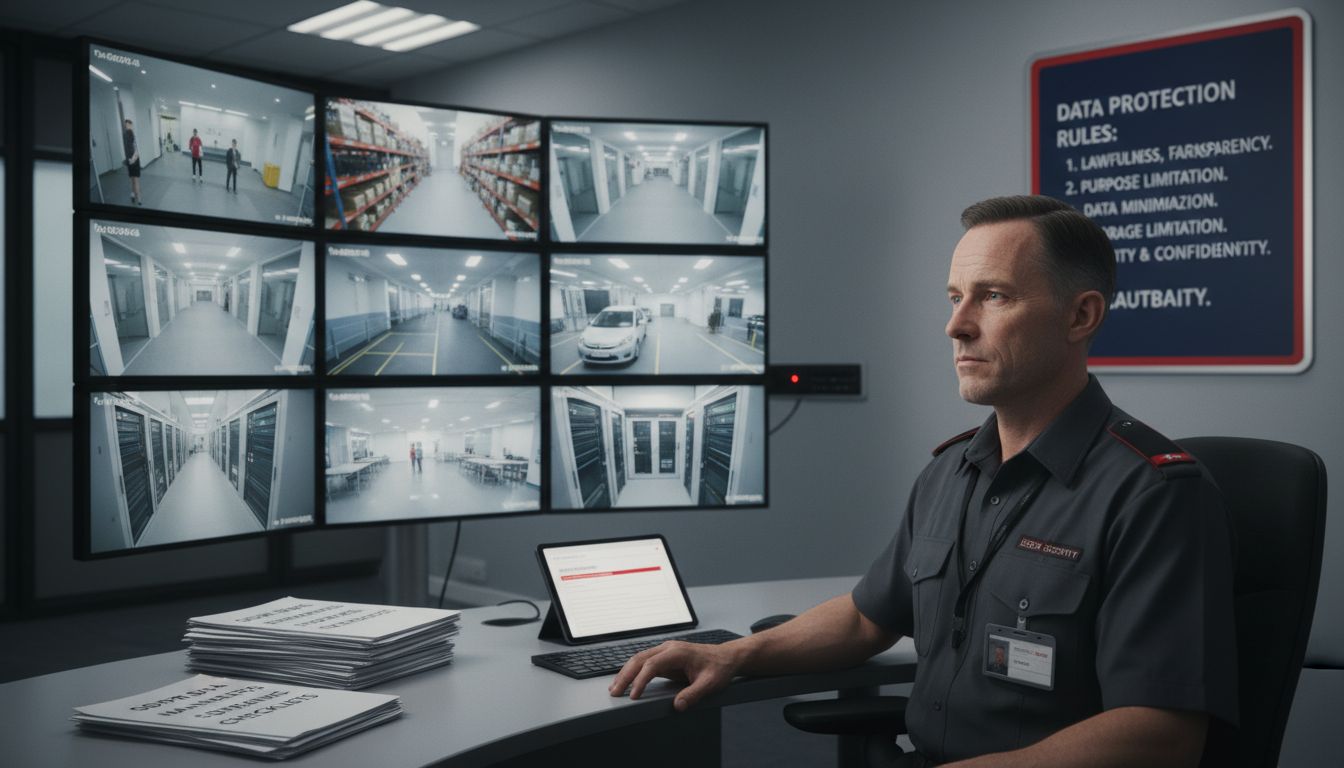Did you know that over five million CCTV cameras are in use across the UK, making it one of the most surveilled countries worldwide? As video surveillance becomes more common, both businesses and homeowners face growing responsibilities to protect privacy and comply with detailed legal requirements. Understanding the fine line between security and personal rights will help you avoid costly mistakes and maintain trust while keeping your property safe.
Table of Contents
- Defining CCTV And Regulatory Framework
- UK GDPR And Data Protection Obligations
- Surveillance Camera Code Application In Essex
- Domestic CCTV Requirements And Signage
- Accountability, DPIAs And Fees
- Risks, Non‑Compliance And Best Practices
Key Takeaways
| Point | Details |
|---|---|
| CCTV Purpose | CCTV systems are essential for crime prevention, safety monitoring, and providing forensic evidence, necessitating a balance with privacy considerations. |
| Regulatory Compliance | Organizations must adhere to UK GDPR and Data Protection standards, ensuring surveillance is lawful, proportionate, and protects individual privacy rights. |
| DPIA Requirement | Conducting a Data Protection Impact Assessment (DPIA) is mandatory to evaluate privacy risks and establish accountability in CCTV operations. |
| Best Practices | Regular audits, stringent data access controls, and clear staff training are critical for mitigating legal risks and ensuring responsible CCTV usage. |
Defining CCTV And Regulatory Framework
Closed Circuit Television (CCTV) represents a sophisticated security monitoring system designed to record and track activities in specific areas. Video surveillance plays a critical role in preventing crime, enhancing safety, and providing crucial evidence when incidents occur. According to guidance from the Information Commissioner’s Office guide on video surveillance, these systems must balance technological capabilities with strict privacy considerations.
At its core, a CCTV system involves cameras strategically positioned to capture visual data within defined spaces. These systems serve multiple purposes:
- Preventing potential criminal activities
- Monitoring movement in secure areas
- Detecting safety threats
- Providing forensic evidence for investigations
Under UK regulatory frameworks, organizations must adhere to stringent guidelines when deploying CCTV. The primary legal considerations involve protecting individual privacy while maintaining legitimate security objectives. Our comprehensive guide on workplace safety highlights that any video surveillance must be proportionate, transparent, and comply with data protection regulations.
Regulatory compliance requires organizations to implement CCTV systems that capture only relevant information, respect personal privacy, and follow established legal standards. This means carefully designing camera placement, ensuring data is securely stored, and limiting unnecessary personal data collection. Businesses must demonstrate their surveillance approach is justified, minimally invasive, and strictly necessary for their specific security requirements.
UK GDPR And Data Protection Obligations
The UK General Data Protection Regulation (UK GDPR) establishes critical legal frameworks governing how organizations collect, process, and manage personal data captured through video surveillance systems. According to the Information Commissioner’s Office, organizations must ensure their CCTV operations are fundamentally lawful, transparent, and respectful of individual privacy rights.
Key data protection obligations for CCTV systems include:
- Obtaining explicit consent for data collection
- Providing clear information about surveillance purposes
- Implementing robust data security measures
- Limiting data retention periods
- Ensuring individuals can request access to their recorded information
Under the Data Protection Act 2018, businesses must demonstrate that their video surveillance is proportionate and necessary. This means CCTV systems cannot be deployed arbitrarily but must address specific, legitimate security concerns. Our workplace safety guide emphasizes the importance of conducting thorough impact assessments before implementing any monitoring technology.
Practical compliance involves developing comprehensive privacy policies, training staff on data handling procedures, and maintaining transparent communication with individuals who may be recorded. Organizations must also implement technical safeguards like restricted camera angles, secure data storage, and controlled access to surveillance footage. Failure to adhere to these regulations can result in significant financial penalties and reputational damage.

Surveillance Camera Code Application In Essex
The Surveillance Camera Code of Practice provides a comprehensive framework for responsible CCTV deployment across Essex and the wider UK. Introduced under the Protection of Freedoms Act 2012, this code establishes critical guidelines to ensure surveillance technologies are used ethically and transparently. Our latest news updates highlight the ongoing evolution of these regulatory standards.
Key principles of the Surveillance Camera Code include:
- Demonstrating that camera use is necessary and proportionate
- Protecting individual privacy rights
- Ensuring clear signage about surveillance areas
- Implementing strict data management protocols
- Maintaining accountability for camera operations
In Essex, local authorities and businesses must carefully navigate these regulations to maintain legal compliance. This means conducting thorough impact assessments, limiting camera coverage to specific security objectives, and preventing unnecessary intrusion into personal spaces. Organizations must be prepared to justify their surveillance strategies and demonstrate they are using technology responsibly.
Practical implementation requires ongoing training, regular system audits, and a commitment to transparency. Essex-based organizations must develop robust policies that align with national guidelines, ensuring that CCTV systems serve genuine security needs while respecting individual privacy rights. By adhering to these principles, businesses can create safer environments without compromising personal freedoms.
Domestic CCTV Requirements And Signage
Homeowners in Essex must navigate complex legal requirements when installing domestic CCTV systems, particularly when cameras potentially capture areas beyond their property boundaries. According to the Information Commissioner’s Office, individuals are legally obligated to ensure their surveillance activities respect privacy and comply with data protection regulations. Our essential home CCTV guide provides comprehensive insights into responsible camera deployment.
Key domestic CCTV requirements include:
- Ensuring cameras only capture necessary areas
- Displaying clear warning signs about surveillance
- Limiting footage retention periods
- Protecting recorded data from unauthorized access
- Respecting neighbours’ privacy rights
Proper signage is crucial for legal compliance. Homeowners must prominently display notices that inform individuals they are entering a surveilled area. These signs should be visible, readable, and provide clear information about the purpose of surveillance, helping to prevent potential legal challenges and demonstrating transparency.
Practical implementation requires careful camera positioning and ongoing management. Homeowners should conduct regular reviews of their CCTV setup, ensuring that recording remains proportionate and necessary. By understanding and respecting legal boundaries, residents can create effective security solutions that protect their property while maintaining neighbourly relationships and legal integrity.
Here’s a summary of key UK CCTV regulatory requirements for different settings:
| Regulatory Focus | Commercial & Public CCTV | Domestic CCTV |
|---|---|---|
| Legal Framework | UK GDPR Data Protection Act 2018 Surveillance Camera Code | Data Protection Act 2018 (if capturing beyond boundary) Protection of Freedoms Act |
| Key Obligations | Lawful grounds Impact assessments Clear signage Controlled access Data minimisation | Capture only necessary areas Clear signage Respect neighbours Secure data storage |
| Accountability | Appoint Data Protection Officer Conduct audits Document processing | |
| Regular reviews Owner responsible Transparent communication | ||
| Common Risks | Excessive monitoring Data breaches Non-compliant retention | Recording public areas Lack of signage Neighbour disputes |
Accountability, DPIAs And Fees
The Data Protection Impact Assessment (DPIA) represents a critical mechanism for organizations to evaluate and mitigate privacy risks associated with video surveillance systems. According to the Information Commissioner’s Office, conducting thorough DPIAs is a mandatory requirement for businesses deploying CCTV technologies. Our CCTV monitoring setup guide provides detailed insights into navigating these complex accountability frameworks.
Key components of a comprehensive DPIA include:
- Identifying potential privacy risks
- Assessing the necessity and proportionality of surveillance
- Evaluating potential impacts on individual rights
- Documenting mitigation strategies
- Implementing safeguards to protect personal data
Organizations must also establish clear accountability mechanisms, including appointing a designated Data Protection Officer responsible for overseeing compliance and managing data protection obligations. This role involves regular system audits, maintaining comprehensive records of processing activities, and ensuring transparent communication about surveillance practices.
Fees related to data protection are an important consideration. While organizations may charge reasonable fees for additional copies of requested data, they must provide free access to an individual’s primary personal data. By maintaining rigorous accountability standards and transparent fee structures, businesses can build trust and demonstrate their commitment to responsible data management.
Risks, Non‑Compliance And Best Practices
Operating CCTV systems without rigorous compliance protocols can expose organizations to significant legal and financial risks. According to the Information Commissioner’s Office, non-compliance with data protection regulations can result in substantial penalties, potentially reaching millions of pounds in fines. Our comprehensive installation guide offers critical insights into mitigating these potential risks.
Key risks and best practices include:
- Conducting regular system audits
- Implementing strict data access controls
- Providing comprehensive staff training
- Maintaining clear documentation of surveillance activities
- Ensuring proportionate and necessary recording
The Surveillance Camera Code of Practice emphasizes the importance of proactive risk management. Organizations must develop robust governance frameworks that include ongoing monitoring, periodic reviews, and immediate corrective actions when potential compliance issues are identified. This approach helps prevent unintentional breaches and demonstrates a commitment to responsible surveillance.
Effective risk mitigation requires a holistic approach that balances security needs with privacy protections. By developing transparent policies, investing in staff education, and maintaining meticulous record-keeping, businesses can create a culture of compliance that minimizes legal exposure and protects both organizational interests and individual privacy rights.
Secure Your Essex Property with Expert CCTV Installation and Compliance Support
Navigating the complexities of CCTV regulations in Essex can feel overwhelming. From meeting UK GDPR standards to ensuring your surveillance is proportionate and respectful of privacy rights, the challenges are many. Avoid risks such as data breaches, non-compliance fines, and neighbour disputes by partnering with a security provider who understands these legal frameworks inside out. Our team at 247cctv specialises in installing CCTV, burglar alarms, and access control systems tailored to both residential and commercial needs — ensuring your system is not only effective but fully compliant.

Ready to protect your property and stay confidently within the legal requirements? Discover how our comprehensive CCTV monitoring setup guide can help you establish a secure system with accountability and transparency. Learn practical steps to implement your surveillance responsibly by visiting our expert resources, or take the next step today by contacting us through 247cctv.co.uk for a personalised consultation. Don’t leave your security to chance when compliance and peace of mind are just a call away.
Frequently Asked Questions
What are the key legal requirements for deploying CCTV in Essex?
Organizations in Essex must comply with the UK GDPR, the Data Protection Act 2018, and the Surveillance Camera Code of Practice. This includes conducting impact assessments, ensuring lawful grounds for surveillance, and maintaining clear signage informing individuals about the surveillance.
How can homeowners ensure their domestic CCTV complies with data protection regulations?
Homeowners should ensure that their cameras only capture necessary areas, display clear warning signs about surveillance, limit data retention periods, and protect recorded data from unauthorized access. Respect for neighbors’ privacy rights is also crucial.
What is a Data Protection Impact Assessment (DPIA) and why is it important for CCTV compliance?
A Data Protection Impact Assessment (DPIA) is a process to evaluate potential privacy risks associated with video surveillance. It helps organizations assess the necessity and proportionality of surveillance, document mitigation strategies, and establish accountability, ensuring compliance with data protection laws.
What are the consequences of non-compliance with CCTV regulations?
Non-compliance with CCTV regulations can lead to significant legal and financial risks, including substantial penalties and fines from regulatory bodies. This highlights the importance of maintaining rigorous compliance protocols and regular system audits.

